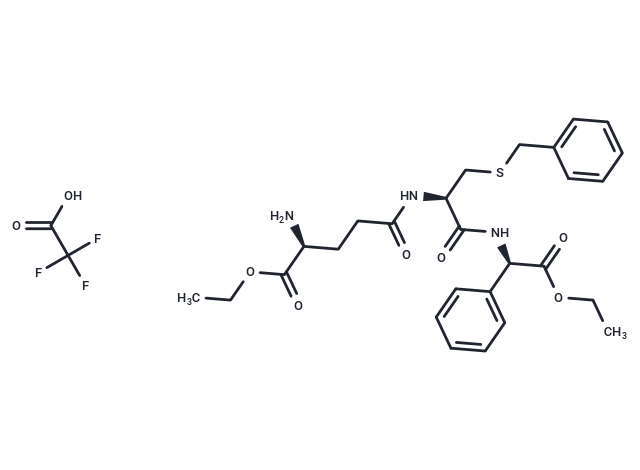Shopping Cart
Remove All Your shopping cart is currently empty
Your shopping cart is currently empty
Ezatiostat TFA (TLK199) is a liposomal small-molecule glutathione analog inhibitor of glutathione S-transferase (GST) P1-1 with hematopoiesis-stimulating activity.

| Pack Size | Price | USA Warehouse | Global Warehouse | Quantity |
|---|---|---|---|---|
| 1 mg | $50 | In Stock | In Stock | |
| 5 mg | $60 | In Stock | In Stock | |
| 10 mg | $102 | In Stock | In Stock | |
| 25 mg | $233 | In Stock | In Stock | |
| 50 mg | $308 | In Stock | In Stock | |
| 100 mg | $477 | In Stock | - | |
| 1 mL x 10 mM (in DMSO) | $116 | In Stock | In Stock |
| Description | Ezatiostat TFA (TLK199) is a liposomal small-molecule glutathione analog inhibitor of glutathione S-transferase (GST) P1-1 with hematopoiesis-stimulating activity. |
| In vitro | Ezatiostat is a tripeptide analog of glutathione that can selectively inhibit GSTP1-1 catalytic activity (Ki = 400 nM) with minimal effect on the related GSTα and -μ families (Kis range from 20-75 μM)[1]. |
| Synonyms | TER199(free base), Ezatiostat TFA (free base) |
| Molecular Weight | 643.67 |
| Formula | C29H36F3N3O8S |
| Smiles | OC(C(F)(F)F)=O.CCOC([C@@H](N)CCC(N[C@@H](CSCC1=CC=CC=C1)C(N[C@H](C2=CC=CC=C2)C(OCC)=O)=O)=O)=O |
| Relative Density. | no data available |
| Color | White |
| Appearance | Solid |
| Storage | Powder: -20°C for 3 years | In solvent: -80°C for 1 year | Shipping with blue ice/Shipping at ambient temperature. | |||||||||||||||||||||||||
| Solubility Information | DMSO: 25 mg/mL (38.84 mM), Sonication is recommended. | |||||||||||||||||||||||||
Solution Preparation Table | ||||||||||||||||||||||||||
DMSO
| ||||||||||||||||||||||||||
| Size | Quantity | Unit Price | Amount | Operation |
|---|

Copyright © 2015-2025 TargetMol Chemicals Inc. All Rights Reserved.